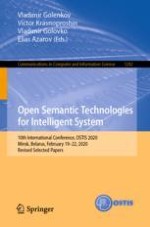2020 | Book
Open Semantic Technologies for Intelligent System
10th International Conference, OSTIS 2020, Minsk, Belarus, February 19–22, 2020, Revised Selected Papers
Editors: Vladimir Golenkov, Prof. Victor Krasnoproshin, Vladimir Golovko, Elias Azarov
Publisher: Springer International Publishing
Book Series : Communications in Computer and Information Science
